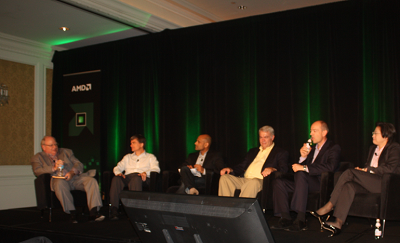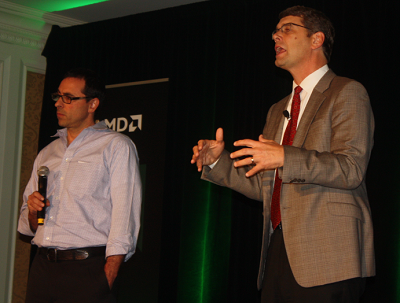Hoping to disrupt the market for data center chips, Advanced Micro Devices announced today that it will offer ARM-based server chips in the future. This strategic move is akin to a major league baseball team switching to football.
“This is a historic day,” said Rory Read (pictured), chief executive of AMD, the No. 2-maker of Intel-compatible chips.
 AMD’s mainstay is designing x86 chips for PCs and data center computers known as servers. Thanks to the internet, data center chips are growing in sales at a rate of 33 percent a year. But the problem is power consumption. Electricity is becoming the biggest cost in data centers, and chips that are too hot are in danger of melting down.
AMD’s mainstay is designing x86 chips for PCs and data center computers known as servers. Thanks to the internet, data center chips are growing in sales at a rate of 33 percent a year. But the problem is power consumption. Electricity is becoming the biggest cost in data centers, and chips that are too hot are in danger of melting down.
AI Weekly
The must-read newsletter for AI and Big Data industry written by Khari Johnson, Kyle Wiggers, and Seth Colaner.
Included with VentureBeat Insider and VentureBeat VIP memberships.
So AMD will now design chips based on the ARM architecture, which typically has lower computing performance but much better power consumption. ARM-based chips are the heart of low-power portable devices such as tablets and smartphones. Now AMD will create 64-bit ARM-based processors that can be used in data center servers.
Those server chips will use less power, which allows more chips to be put in the same space without overheating. That, in turn, allows for more densely packed server chips. AMD will also bring to bear a new networking technology, dubbed a fabric, that it acquired with its purchase of Sea Micro earlier in the year. Sea Micro’s fabric allows chips to communicate within servers at much faster rates, allowing the low-power server chips to work together in a more efficient manner.
“It’s all about power and efficiency,” said Jay Parikh, vice president of infrastructure engineering at Facebook, who spoke at the AMD event in a panel that included representatives from ARM, Red hat, Dell, and analyst Nathan Brookwood of Insight 64. The improved chips and server technology will make it easier for corporations to deploy huge clouds, or web-connected data centers that centralized a lot of processing and storage tasks.
“There is no doubt that the cloud changes everything,” Read said. “The cloud is the killer application that is driving industry forward. We are uniquely positioned to lead in the era of cloud processors.”
 Sea Micro pioneered a new class of servers known as “micro servers.” They included Intel’s low-power Atom chips that had older processing technology but used significantly less power. Sea Micro launched its first micro servers in 2010, putting 512 processors in a small cabinet that was about a quarter the size of a usual server cabinet. They also used a quarter of the power.
Sea Micro pioneered a new class of servers known as “micro servers.” They included Intel’s low-power Atom chips that had older processing technology but used significantly less power. Sea Micro launched its first micro servers in 2010, putting 512 processors in a small cabinet that was about a quarter the size of a usual server cabinet. They also used a quarter of the power.
“Why is it important?” Read said. “The ecosystems are going to continue to evolve. We’ll apply the technology to segments where it has the best fit. We think ARM will play an important role. The x86 won’t go away. It will be around a long time.””
Patrick Moorhead, analyst at Moor Insights & Strategy, said, “AMD’s announcement gives a lift to the entire micro-server market, and launch contributions from Facebook, Amazon, RedHat and Dell, help, too. AMD brings over a decade of server experience at the chip-level and can offer customers AMD, Intel and now ARM solution choices. Intel, who currently has over 95 percent market share in the entire server market, has a while to formulate a response given 64-bit ARM servers ship in 2014.”
Read said the micro-server segment of servers will be the fastest growing segment of the server industry over the next five years. Lisa Su, senior vice president of AMD, said the ARM license will change over time as AMD moves more deeply into the business. For now, AMD is licensing a 64-bit core from ARM.
“The market will develop over time,” Su said. “The engineering teams are well under way.”
At some point in the future, AMD could still go deeper with the relationship by designing its own cores and doing a lot more customization by securing a license that allows it access to the ARM instruction set. That is the kind of license that Apple has with ARM. But the licensing an ARM core is the first step in that process. The delivery of the first chips is set for 2014, since ARM still has to finish the core in question and then AMD will have to do work integrating that core into a full working, fully tested chip.
In a separate conversation, Intel fellow Matt Adiletta said in an interview with VentureBeat that his own company has been exploring micro server technology going back as far as 2007-2008, when the focus was on low-power “server blades.” Over time, Intel has also become interested in the micro server market, but it did allow the market leader, Sea Micro, to be acquired by AMD.
“With its planned 64-bit ARM solutions, AMD brings the experience of a proven enterprise CPU provider to the ARM ecosystem,” said Jimmy Pike, vice president and senior fellow of the Dell Data Center Solutions group. “ARM has the promise of being a serious player in areas like web front-end servers and as a worker node in a Hadoop environment. AMD’s opportunity is to deliver serious value in performance-per-dollar and performance-per watt-where low-power server platforms running massively scale out workloads can shine. The availability of 64-bit ARM solutions is an essential milestone needed to accelerate enterprise adoption of this technology.”
Brookwood said that the strategy is a good one for AMD, since Intel is very unlikely to take a license from ARM, which is Intel’s arch competitor these days. And AMD, which is far smaller than Intel, has to do things that Intel can’t or won’t copy.
“If you are AMD, you have to do things that Intel doesn’t want to do,” Brookwood said. “This is one of those things.”
VentureBeat's mission is to be a digital town square for technical decision-makers to gain knowledge about transformative enterprise technology and transact. Learn More

